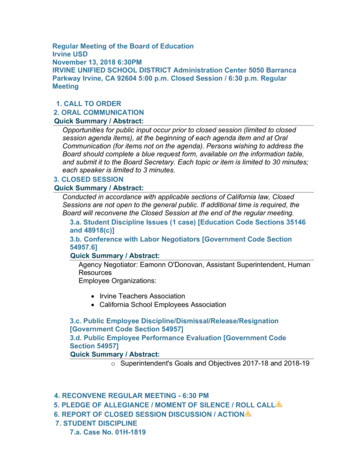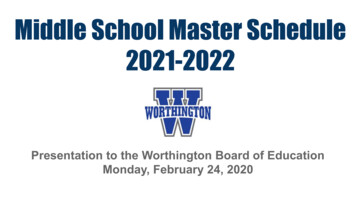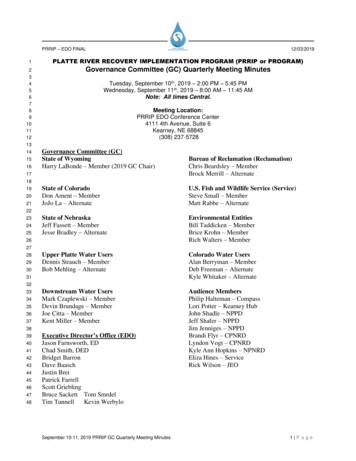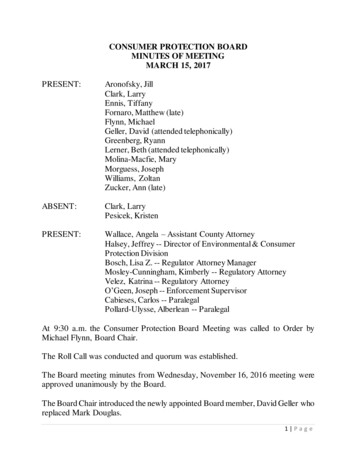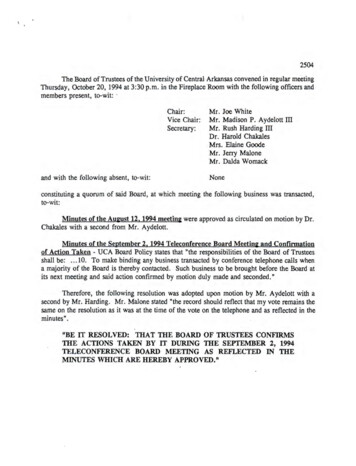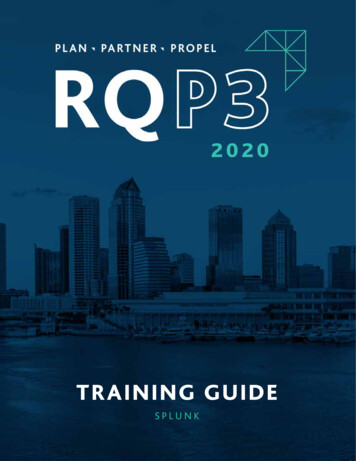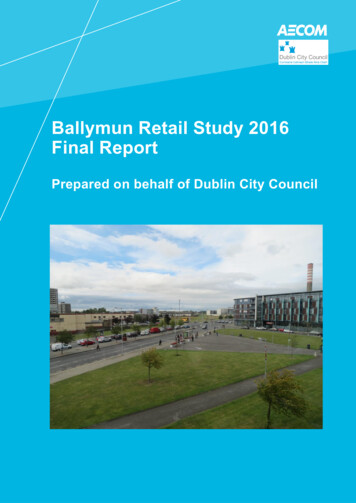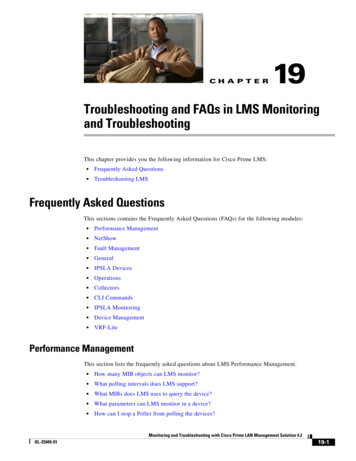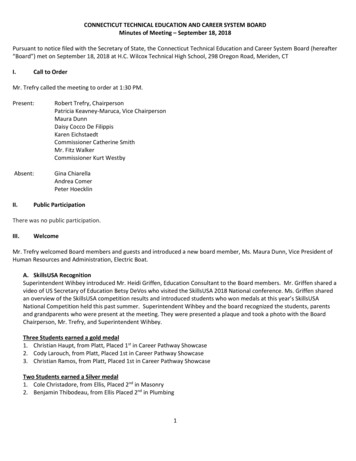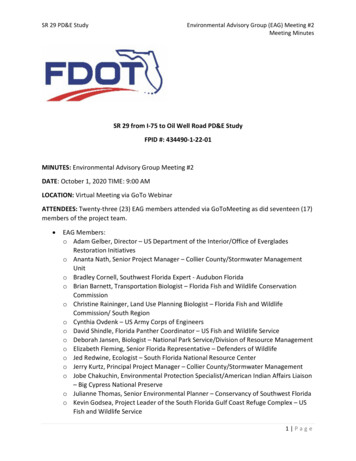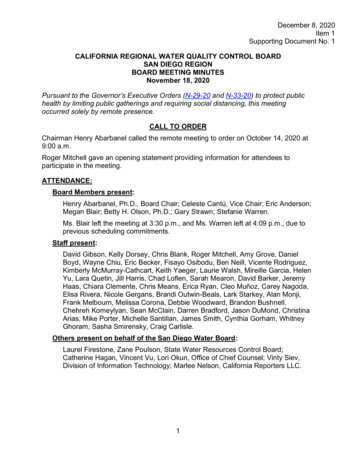
Transcription
APPROVEDDECEMBER 4, 2018Item #G-1December 4, 2018MINUTES – BOARD MEETINGSeptember 18, 2018Submitted for:Action.Summary:Minutes of the September 18, 2018, meeting of the Illinois Board ofHigher Education held at Eastern Illinois University, Charleston, Illinois.Action Requested:That the Illinois Board of Higher Education approve the open and closedsession minutes of the September 18, 2018, Board meeting and keep theclosed session minutes closed as the need for confidentiality exists due tolitigation matters.249
250
Item #G-1December 4, 2018STATE OF ILLINOISBOARD OF HIGHER EDUCATIONMINUTES – BOARD MEETINGSeptember 18, 2018A meeting of the Illinois Board of Higher Education was called to order at 1:04 p.m. in theGrand Ballroom at Eastern Illinois University, Charleston, Illinois, on September 18, 2018.The following Board members were present: Tom Cross, Chair, John Bambenek, JayBergman, Emily Buice, Max Coffey, Meredith Daw, Sherry Eagle, Jane Hays, Alice Marie Jacobs,Cherilyn Murer, Santos Rivera, Jack Thomas and Eric Zarnikow.Others present: Mark S. Jamil, Burke, Burns & Pinelli, LTD.; Dr. Larry Dietz, IllinoisState University; Dr. David Glassman, Eastern Illinois University; Dr. Al Bowman, Illinois Boardof Higher Education; Dr. Curt Oldfield, Spoon River College; Dr. Lisa Freeman, Northern IllinoisUniversity; Dr. Elaine Maimon, Governors State University; Dr. Gloria Gibson, NortheasternIllinois University; Dr. Z Scott, Chicago State University; Ms. Amy King, DeVry University; Mr.Dave Tretter, Federation of Independent Illinois Colleges and Universities; Ms. Cindy Deitsch,Illinois Board of Higher Education; Dr. Stephanie Bernoteit, Illinois Board of Higher Education;Dr. Eric Lichtenberger, Illinois Board of Higher Education; Dr. Arthur Sutton, Illinois Board ofHigher Education; Mr. Nyle Robinson, Illinois Board of Higher Education; Ms. Jaimee Ray, IllinoisBoard of Higher Education; and Ms. Melissa Hahn, Illinois Board of Higher Education.I.Call to Order/Roll Call Call Meeting to Order, Vice Chair Jane HaysVice Chair Hays called the meeting to order. Secretary Deitsch took roll call, a quorumwas present.Vice Chair Hays indicated that Board members Sherry Eagle, Alice Marie Jacobs, DarleneRuscitti, and Santos Rivera are unable to attend the Board meeting in person due to businessreasons, but will be joining by telephone. Vice Chair Hays requested a motion for telephoneparticipation for the foregoing Board members.The Illinois Board of Higher Education, on motion made by Mr. Jay Bergman andseconded by Dr. Jack Thomas, to allow for Drs. Sherry Eagle, Alice Marie Jacobs, DarleneRuscitti, and Santos Rivera to participate in the meeting via telephone conference pursuant toSection 7(a) of the Illinois Open Meetings Act, unanimously approved Board Members SherryEagle, Alice Marie Jacobs, Darlene Ruscitti, and Santos Rivera to participate via telephoneconference call.251
II.Welcome and Remarks Welcome by Dr. David Glassman, President, Eastern Illinois UniversityDr. Glassman welcomed everyone to Eastern Illinois University. Welcome and remarks by Chair Tom CrossVice Chair Hays thanked Dr. Glassman for hosting the Illinois Board of Higher Education(IBHE).The IBHE Student Advisory Committee held its first meeting of the academic year onSaturday. Seventeen students from across Illinois, representing public, private, and communitycolleges attended the meeting. IBHE’s two student board members were elected at that meeting:Emily Buice, a senior studying history and public relations with a political science minor atSouthern Illinois University Carbondale. She is originally from Tallassee, Alabama. While atSIUC, she has served as the Undergraduate Student Government President, College PanhellenicExecutive Vice President, and Vice President of Communication and Engagement for the SalukiAmbassadors. She completed an internship as a public diplomacy intern with the U.S. Mission tothe E.U. this past summer and has worked as the Carbondale Chamber of Commerce's marketingintern since January 2018. Vice Chair Hays welcomed Emily to the Board.Jack Luu, who was not able to join the meeting, is a full-time student at HeartlandCommunity College and a part-time graduate student at Illinois State University. He is working asa master tutor at Heartland Tutoring Services and as an office assistant in the college’s StudentEngagement Department. He serves as the student government association’s president fromHeartland Community College. His main priority of serving as the non-traditional Student BoardMember is to collaborate with IBHE members as well as external entities to provide academic andlife support services to ensure success for traditional and nontraditional students in Illinois. Healso works closely with other Student Advisory Committee members to optimize thecommunication flow so that the student voice can be heard by our leadership.Vice Chair Hays also welcomed Chicago State University’s new president, Dr.Zaldwaynaka “Z” Scott, to the meeting.Vice Chair Hays shared some good news about colleges and universities in Illinois. Withthe Fiscal Year 2019 budget’s two percent increase overall, there is hope that we will continue onan upward slope so that universities can better fund emergency repairs, count on operational money,and pursue capital projects where appropriate. IBHE is thinking ahead for Fiscal Year 2020planning, and everyone will be pleased with the level of investment that is being pursued. Thegovernor’s office just released funding for 28 emergency capital projects. The University FundingFormula Working Group met recently and Nyle Robinson, deputy director for Fiscal Affairs andBudgeting, will explain the budget planning, details of the capital projects, and funding formuladevelopments later in the meeting.Preliminary enrollment data indicates that most universities are seeing a small increase infreshman enrollments. And this was before Governor Rauner signed the priority Monetary AwardProgram (MAP) grant funding for returning students, the AIM HIGH merit-based scholarships, andthe lifting of the cap on dual-credit credits. Hopefully these three important bills will mean moreIllinois high school graduates will attend Illinois colleges and universities next year.252
Included in the board packet is a copy of the annual report on academic programs at publicinstitutions. We appreciate the institutions’ dedication in scrutinizing their programs and makingdecisions on whether to enhance some programs, or perhaps discontinue programs. The report wasalso sent to the legislature.IBHE issued a Data Point and a news release on the now college transfer report that putsIllinois as number one. This report, by the National Student Clearinghouse Research Center,measures how many community college students end up with bachelor’s degrees within six years.More specifically, it breaks out how many of those first-time college students transfer to four-yearinstitutions and earn a bachelor’s in six years. Illinois came in with 53.8 percent, above secondplace Washington state at 50.7 percent, third place Iowa at 49.7 percent, and well above the nationalaverage of 42.2 percent.The Public University Trustee Training Conference just ended and we hope those of youwho attended found it helpful.Finally, Vice Chair Hays welcomed IBHE’s new public information officer, Melissa Hahn.Melissa is already working to increase IBHE’s social media presence and has issued a news release,so it is not taking her long to fit into the role. Remarks by Executive Director, Dr. Al BowmanDr. Al Bowman thanked President Glassman for hosting the meeting and complimentedEastern Illinois University (EIU) on their hard work they have done on enrollment. EIU was oneof three institutions that showed an overall increase in enrollment, as well as an increase in graduateenrollment.The capital dollars that were just released are very important as there has not been capitalfunding for a number of years. IBHE recognizes that the needs are very great with over 5 billionin deferred maintenance projects that will need to be addressed. These dollars, while important arevery a small step in a positive direction. We hope the dollars continue to flow.Dr. Bowman introduced board member Cherilyn Murer to make an introduction.Ms. Cherilyn Murer announced the new president of Northern Illinois University, Dr. LisaFreeman. Dr. Freeman has been acting president for 18 months.III.Reports and Updates Advisory Committee Report – Ms. Amy King, Proprietary Advisory CommitteeMs. Amy King, Vice Chair of the Proprietary Advisory Committee (PAC) and GroupPresident for DeVry University, Central Region, addressed the Board. Chair Robert Gabriel wasunable to attend the meeting.The PAC has been a proud partner of IBHE since 1974 and is comprised of 22 collegesand universities serving students throughout Illinois. The PAC is committed to partnering withIBHE on matters affecting long term higher education goals in the state of Illinois and in particularhelping to exceed the state goal of 60 percent of adults holding a postsecondary degree or credentialby 2025 (60 x 2025). To achieve this goal the PAC colleges and universities recognize the needfor affordable higher education coupled with quality outcomes for all students. The PAC colleges253
and universities have historically served a higher proportion of non-traditional students describedby the National Center for Education Statistics as having one or more several characteristicsincluding being independent for financial aid purposes. Students over age 24 are also characterizedas non-traditional and these students are particularly in need for affordable higher education. Oneway to support affordability for students is the funding of the MAP. According to the IllinoisStudent Assistance Commission’s 2017 MAP evaluation, MAP is below the dollar levels from2009. Serving only about half of the eligible applicants in all of Illinois’ institutions. Fifty-eightpercent of eligible students in 2017 did not receive funds. In 2017 MAP funding specific to PACcomprised only 3.3 percent of the total students receiving MAP grants. Of those students 74 percentwere independent. The need for MAP grants is significant. The PAC is pleased to see the new billproviding priority access grants for returning students. The members of PAC would like to see allMAP eligible students receive full MAP grant funding at all colleges and universities, public andprivate alike meeting the MAP criteria. The PAC will be working in the future to provide additionalinsights into its impact in serving all students. Advisory Committee Report – Mr. Dave Tretter, Federation of IndependentIllinois Colleges and UniversitiesMr. Dave Tretter, President, Federation of Independent Illinois Colleges and Universities(FIICU) addressed the Board. FIICU consists of about 60 non-profit colleges and universitiesaround the state and was formed in 1904. Mr. Tretter is the fourth president of FIICU.Mr. Tretter thanked the staff at IBHE for all their work and specifically highlighted thedata points that have been produced. The data points are very important and have been usefultalking points when talking to the legislature, specifically talking about refocusing on highereducation.Mr. Tretter thanked Dr. Bowman for his collegial invitation to serve on the performancefunding committee. It has been eye opening in many ways. It has put a fine point on the need forstable and predictable funding for all of higher education including MAP and operational funds.FIICU’s executive committee had a meeting with about half of the members of the GeneralAssembly’s higher education working group. It was an interesting discussion and reinforced thatthere are some legislators that recognize the damage that has been done and are working to find asolution. Mr. Tretter stressed that the independent colleges need to be involved in thatconversation. It is important to put the two groups together working to improve all of highereducation in the state, along with the community colleges. The work between the two- and fouryear institutions was validated last week when looking at the transfer data. Everyone should befocusing on the route for an Illinois resident to find their way through higher education, both publicand private.In a few weeks Mr. Tretter will meet with IBHE staff to make the case for heightenedrecognition of the state’s independent institutions along the lines of what was just mentioned. Withthe support for need-based funding and some direct funding independent institutions can contributeas they have to improve the state’s higher education.Whereupon, Chair Cross entered the room254
IV.Presentation/DiscussionMr. Nyle Robinson provided an update on the public university funding formula and apresentation on the Preliminary Context and Planning for Fiscal Year 2020 Budget Development. Public University Funding Formula UpdateThe public university funding formula working group represents the universities and otherinterested organizations.The state universities in Illinois have never had a full-fledged systematic base fundingformula. Illinois may be the only state who does not have a base funding formula. It is not requirednor is it prohibited in state law. There were some regular realignments of funding through 1995which coincided with the realignment of higher education in Illinois and was based on an averagesubsidy per student for universities. That is much less complicated than what is done now. Therehas been no systematic realignment of funding based on base funding since Fiscal Year 2004.IBHE has been mandated to recommend allocations based on a performance fundingformula since Fiscal Year 2013. It was only used during the first year on the basis of one-half of apercent. The current formula is closely linked to the current law. For Fiscal Year 2019 it was againrecommended at 0.5 percent. That was not accepted by the General Assembly so it was notimplemented. The greatest loser in the formula as it currently stands would have been just .15percent and the greatest winner would have been 0.3 percent. IBHE initially decided theperformance funding formula should be reviewed in five years and that time has come.Following the passage of the new K-12 formula the General Assembly noted to IBHE thatthey were very pleased with having that formula and that there are several community collegesformulas, but there is not an overall university funding formula. The Higher Education WorkingGroup (HEWG) of the General Assembly is clearly interested in a base funding formula. Years ofchange without adjustments have created distortions. In other states where there may have beenrealignments in enrollment and other factors are making annual adjustments and have not gotten tothe place Illinois is in terms of distortions. Several elements of the performance funding formulaare perfectly aligned with what would be in a base funding formula. The working group has alsobeen asked to consider the base funding formula.The public university funding formula working group met on August 13, August 23, andSeptember 11. The group reviewed the current formula, looked at options for different elements,and considered items that might be added or modified based on a base funding formula. The groupis now looking at formulas from other states. It is important to note in this research thatperformance funding formulas have actually not produced meaningful results in other states whereis has been fully implemented. The research indicates that it has not created significantperformance improvements. It is not surprising that Illinois has not had results because it has notbeen fully implemented. Research shows that the formula should be transparent but our currentformula is complicated.The group understands there needs to be a base funding formula however they areconcerned about the time required to implement a base formula and how quickly it will beimplemented. The HEWG asked IBHE to deliver a presentation and have discussions with them.Mr. Robinson made the presentation to the group.255
The funding formula committee had a number of questions they asked the HEWG:(1) Should the formula be performance or mainly base funding formula? TheHEWG’s interest was primarily on the base funding formula while maintainingelements of the performance funding formula.(2) What is the timeframe? A timeframe for moving forward was recommended towhich the HEWG seemed amenable.(3) What portion of funds should be included? The HEWG did not expect it to beshock therapy and that it should be implemented over a phased in period.(4) Should it be new funds or base funds? There is an expectation that it will be morethan just new funding and perhaps phased in. There was some discussion of howa guarantee might be worked in which is very difficult for various reasons. TheHEWG is sensitive to the concerns of the funding formula working group.(5) What priorities in missions and outcomes should be involved? There is the PublicAgenda, there is the existing performance laws, and there is a clear interest tomaintain and retain students in Illinois. The HEWG did not add to that althoughthe funding formula group can have the discussion in more detail.There is a clear desire from the HEWG to have a base funding formula with performanceelements. It is based on input recommended for Fiscal Year 2020 with an eye to moving to a basefunding formula and try to improve transparency. IBHE would recommend changes to the existinglaw for passage in the next legislative session. IBHE would not be implementing anything differentin any serious way until Fiscal Year 2021, the Board recommendation for the fall of 2019. Thiswas discussed with the funding formula group and they understood how it will move forward. Thefunding formula group prefers to have the current formula rule for the Fiscal Year 2020recommendations and focus efforts on the coming change to the law and moving ahead for anotheryear. The recommendations the Board will receive in December would be based on the currentfunding formula.Mr. Robinson indicated that there has been no consensus on approach. Research iscontinuing. Stability and predictability are very important. There is concern that a new formulawill take away from one school and give it to another school, as well as a feeling that whatever theformula will be it should be based on new incremental dollars so the state is not penalizing oneschool or giving money to one school at the expense of another. The existing performance fundingformula has a situation where a school can see improved metrics but lose money because otherschools are improving faster than they are. There is a concern that it is pitting schools against oneanother for money instead of being a system and working to get better for student outcomes.The current formula treats every campus separately. It is difficult in the formula to treatthe University of Illinois the same as everyone else. They are a large system, which throws off theaverages. That is one of the things that have been discussed among the many factors to consider.The current formula treats each university separately but only considers the small amount of fundsat the top. With a base funding formula there is an assumption that it would treat campusesseparately, and the data used in the formula already runs that way. There is a factor for high costentities, so the formula takes out money. The formula also has a heavy weight on graduation andon spending for research and public service. IBHE staff believes the formula should take missioninto consideration separately. It is throwing things off quite a bit. That will be treated differently.There are some other factors within graduations. There are different factors for harder to reachpopulations such as minority, low income, first generation, adult learners, and STEM. There aresome other options that have been discussed for instance other populations that should be reachedsuch as teachers and veterans. It is not an endless list. Currently enrollment is not used but in the256
current situation with enrollment down and trying to attract Illinois students that is a much betterone to have now.A number of states take in-state students separately into account, since the state is, intheory, subsidizing the university at least in large measure for providing in-state to its ownpopulation. It is not something that is enshrined in the current performance funding formula but itcertainly will be a factor that we are concerned with right now.Mr. Robinson has been involved in implementing in social services from scratch but whenlooking at higher education there are a couple of problems. For higher education IBHE receivesdata points once a year and some of the measures are within a 150 percent of the normal graduationrate for six years. The other one is just how complex universities are compared to other institutionsincluding healthcare. It is a lot more complicated and with a lot more pressures. It is not surprisinghow difficult it is to do this for higher education as it is compared to the social service agencies.Substantial discussion followed as to performance based funding, including the use of thismetric in other states. Mr. Robinson stated that the IBHE staff are not suggesting to give up on thismetric and is trying to better articulate or formulate the measures that count towards performance.Mr. Robinson stated that the research has said it is not working well in other states. The HEWGwants the funding formula group to work on it and the funding formula working group does notwant to abandon the idea. The expectation is more on a base funding formula in terms of findingrealignment on a regular basis.One of the factors in the current formula and will probably be something that getsrecommended is the average cost per unit and average cost per graduation. Of all the factors wewill consider it will be easily discussed as performance. Just noting that it is the emphasis on howto realign the money on a regular basis.Currently the formula has 40 percent bonuses for a series of things like the cost of dealingwith students who come in with certain other deficits: low income; first generation; minorities; andolder students who do not fit into the norm. It is possible to have a student who fits all four of thoseand at 40 percent it would count as if it were 2.6 students. That is one way to overcome thosedeficits both in terms of the costs the university has, recruitment and retention, and supports as wellas actually getting them continuing through the system and not just someone who comes with thehighest ACT score or whatever factor you want to look at. It does not have any of those negativesthat we know we need to get to more of in order to reach our goals going forward. We can considerother factors as we go. Those are the ones that are baked in already. Preliminary Context and Planning for Fiscal Year 2020 Budget DevelopmentThis is the annual review of important trends in higher education as staff prepare for thebudget recommendations that the board will receive in December. Staff are trying to be moreforward thinking this year and trying to start selling their approach sooner and want to do morecollaboration with the public universities.Everything is being compared to Fiscal Year 2002 when funding reached a peak. The nexttwo years there was a decline, then funding fluctuated from 2004 to 2012, but for the total periodit was a .2 percenter per year increase without inflation. From 2013 to 2015, funding decreasedand 2016 was the impasse. That was a value of about 2 billion that was taken out of the system.That is a particular problem. In 2018 there was a 10 percent cut. At this point overall total highereducation state funding is 52.9 percent of what it was in 2002.257
There was funding that did go somewhere in theory for higher education but not to ongoingoperations of higher education. The money was going into the retirement system. Unfortunatelyit is not ongoing retirement system. The retirement for employees who are currently working forthe state is actually in decline every year and is expected to continue to decline. At this point aboutthree-quarters of the dollars that go to the State Universities Retirement System (SURS) are actuallygoing for previous unfunded liabilities. Those costs are going to continue to go up but not forcurrent employees which will actually go down.The three big areas of higher education funding in Illinois are: universities; communitycolleges; and the MAP grant. The public universities have taken the largest hit when taking intoaccount the unfunded mandates that have happened since 2002 and the effect of inflation. That isonly 43.8 percent of what it was in 2002. They received two percent up because inflation wasactually 2.4 percent. The universities fell behind. In the future we will be talking about the HigherEducation Price Index (HEPI) which is more specific to colleges and universities and has beenrunning at a higher rate which means it is worse. Community colleges are at 55.9 percent and thatis only for a couple of small things that have intervened.The AIM HIGH grant program does help the universities in the background but they arerequired to match those funds. It is a bit of money going in one pocket and they have to find a wayto utilize those funds. Remember in 2016 public universities were only 30 percent funded. Thatmoney had to come out of their reserves and is an ongoing issue.The money came from the university’s income fund which means tuition and fees. If youlook back at 2002 that represented 28 percent of the state cost for universities. By the time you getto 2017 (the last year that data is available) it was 62.3 percent. In 2016 state funds actually onlycovered 15 percent of the total.IBHE did an analysis to see how much the universities income fund had to pick up fortuition and fees relative to the amount of funds they lost in state dollars, taking into account forinflation and it accounted for 98.7 percent. It was almost a dollar for dollar match between thedollars that were cut in appropriations and the amount they wound up picking up with tuition fees.Community colleges are supposed to be funded one-third from property taxes, one-third from thestate, and one-third from tuition and fees. That is nowhere near the situation now. In 2002 thepercent from the state was 27.4 percent but at this point for 2017 it is only 14.5 percent. Notsurprisingly it was only 4.2 percent in 2016.In 2002 the MAP grant program funded 100 percent of the eligible applicants at 100 percentof the university tuition and fees. Since that time there are two factors that the Illinois StudentAssistance Commission (ISAC) has to take into account: (1) how many grants they can cover; and(2) how big the grant is. It is now well below 50 percent funding and for 2019 ISAC indicates it tobe estimated at 32.1 percent of what the average weighted tuition and fees are. There weresignificant cuts to the point that even though there was a 10 percent increase for 2018 it is actuallynot at the peak dollar value. It is 401.3 million and the peak was 403.5.Another factor we are going to try to take into account this year is how to emphasize capital.The state has released 74.2 million so far and the community colleges will be released another 11.3 million. If you take into account the 74.2 million plus the 11.3 million that is only 7.9percent of the total amount that has been released. Emergency projects from the communitycolleges and universities is 152 million more. All of the amount appropriated dates back to theIllinois Jobs Now! from Fiscal Year 2010 or other years. These are projects that have been on the258
books for a very long time. Every university and most community colleges have them. There wasno effective capital funding until this year all the way back to 2002. Deferred maintenance hasgrown substantially, from 2.7 billion in 2005 to 6.2 billion in 2019. Universities have 70.8million square feet of space, valued last year at 23.8 billion. The state supported amount was 16.5 million. Over 30 percent of the entirety is actually not state supported.One thing we want to emphasize this year in the principle that we work with is thatbuildings will have a 50 year replacement cycle. That means you need to be actually funding tomeet that goal, you need to have a two percent per year. In other words two percent of 16.5 billionthe state some way or another should be investing. If we were to put in one percent more or another 65 million it would take 28.6 years for the universities to catch up. There is a similar number forcommunity colleges but it is not quite so bad.One of the biggest goals is 60 x 2025. Until 2013 Illinois was progressing toward the goal,but we have gone further below that and are only 85.4 percent of where we need to be. We are notmoving toward the goal. That is a concern that we would want to raise along the way.On terms of pension law changes, the universities are still having to pay for the change thatwas implemented that employers are responsible for the employee normal cost on the amountearned in excess of the Governor’s salary. The optional hybrid plan was not implemented becauseSURS had to go back to the legislature with some changes to clarification in order for it to passthrough the Internal Revenue Service and the legislature chose not to move forward. There arethree buy-out programs. That is not so important to universities directly but the reason to mentionit is that the legislature chose to take all the savings and utilize it the first year which creates a holein the second and following years and will be a drag on the spending. A bigger change for theuniversities was a change to the six percent rule. Universities had to pay normal pension costs forsalary increases over six p
helping to exceed the stat e goal of 60 percent of adults holding a postsecondary degree or credential by 2025(60 x 2025). To achieve this goal the PAC colleges and universities recognize the need for affordable higher education coupled with quality outcomes for all students. The PAC colleges
